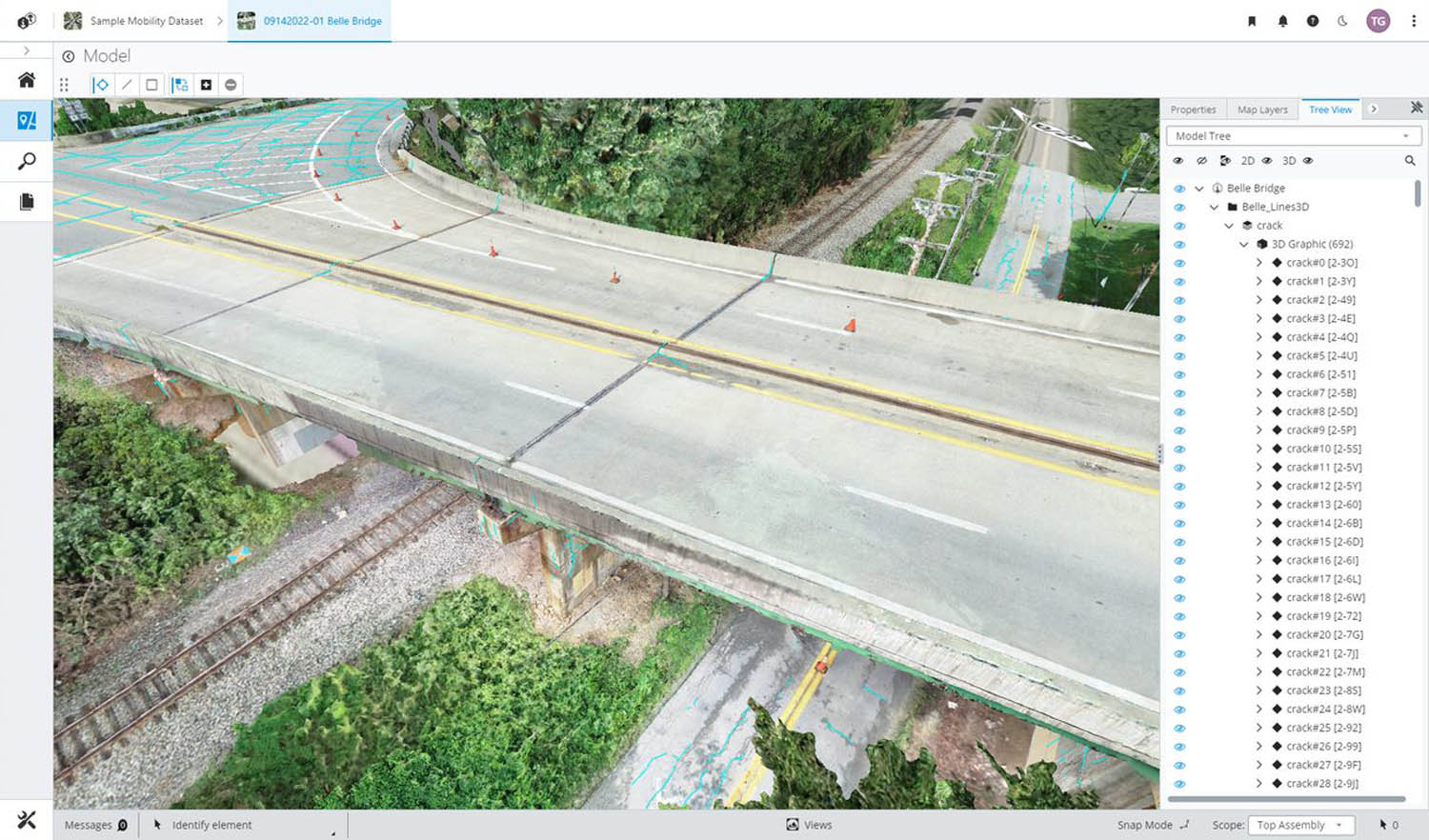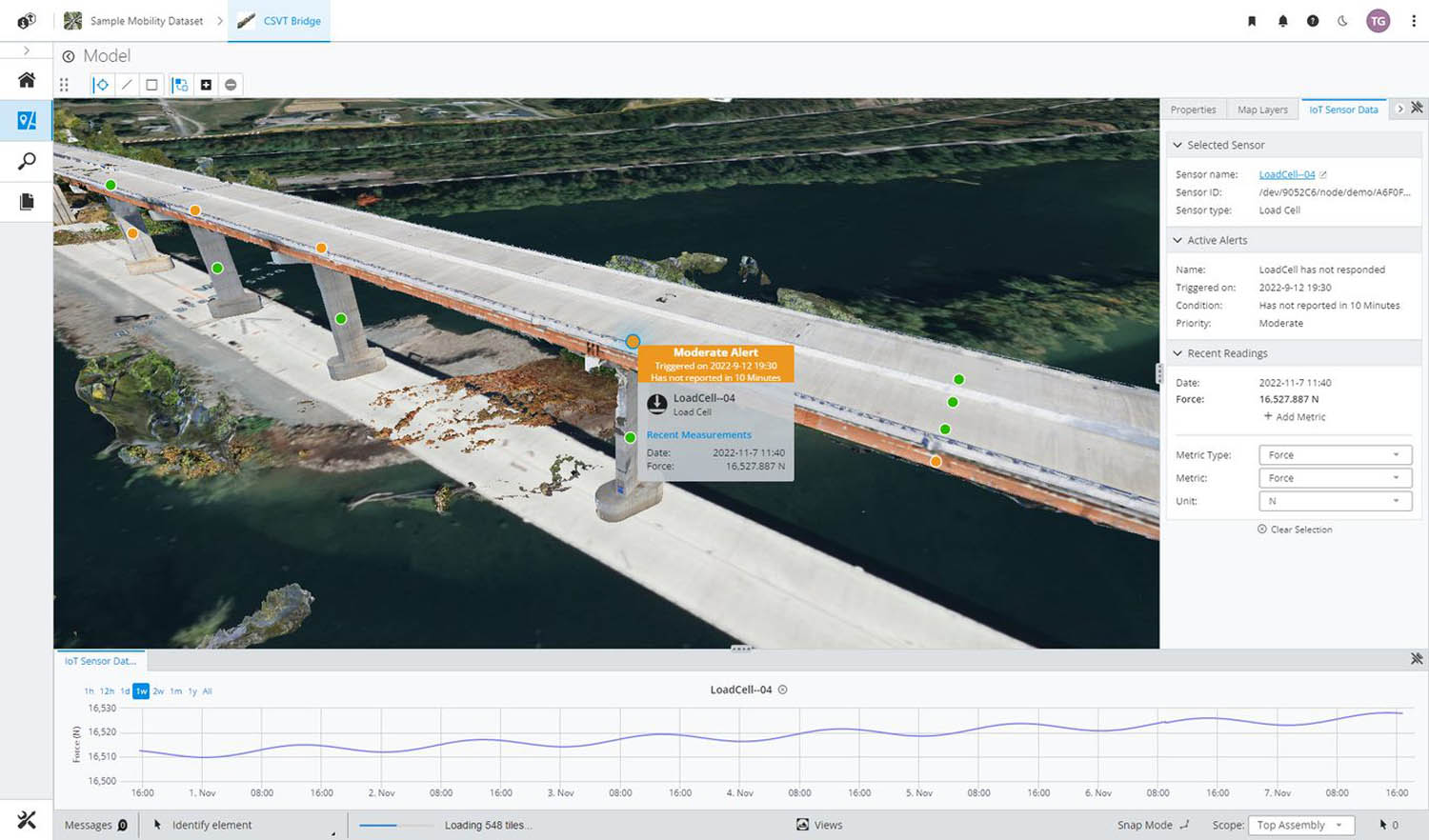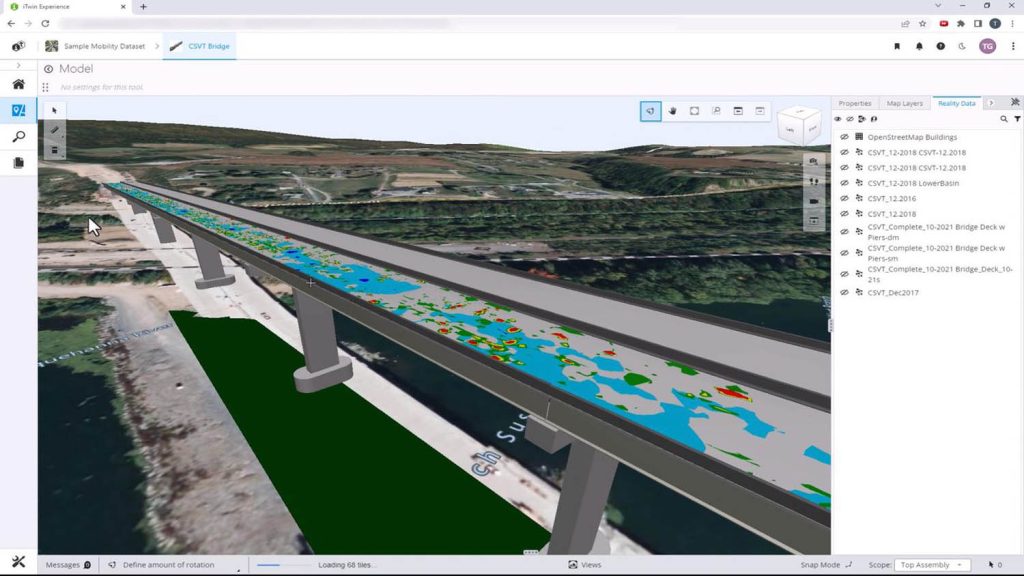In mid-November, the first post-Covid, in-person gathering on all things Bentley Systems took place at YII in London, where the company continued its drive to lead the digital twin infrastructure market with the release of new iTwin products
It is almost four decades since Bentley Systems was founded — or 38 years, to be precise. It’s almost as long since the 1986 launch of MicroStation for DOS, and yet MicroStation continues to be the base platform for the infrastructure software company’s wide range of vertical products. These cover areas as diverse as plant, rail, roads, bridges, dams, telecom, electricity, and water systems.
Having achieved its long-awaited Initial Public Offering (IPO) in 2020, the company recently passed $1 billion in annual revenue, and while its products remain emphatically desktop-based on Microsoft Windows, the Microsoft Azure cloud is now an option, too, when that option makes sense for customers.
Over the past five years, Bentley Systems has been on a mission to persuade infrastructure owners and operators to invest in digital twins of their assets using its iTwin technology, on the promise of better lifecycle management for those assets, as well as to extend their use of asset information, whether it is designed in CAD or modelled from the field using reality-capture technology.
That message seems to be getting across, especially with customers in Asia, with entrants for the company’s Year in Infrastructure (YII) 2022 awards using the iTwin technology significantly outnumbering those from other regions. As CEO Greg Bentley pointed out, 50% of the world’s infrastructure projects are currently happening in Asia.
These Asian companies are using digital twins to address three critical areas, according to Greg Bentley. The first is ‘digital context’, the ability to use and deploy 3D and 4D technologies to capture the physical reality of an asset being twinned. The second is ‘digital chronology’, which focuses on maintaining a database or record throughout the lifecycle of an asset to create what Bentley refers to as an ‘evergreen’ digital twin. The third area is ‘engineering technology’, the ability to model and simulate a facility over the lifetime of a project in order to optimise its efficiency.

But this focus on digital twins is by no means confined to Asia. According to a survey of infrastructure CEOs conducted at the event by AEC Advisors, when asked about their main concerns over the next three years, it was clear that respondents are worrying less about 2D drawings and more about 3D models. Almost one in five said their companies were evaluating and deploying digital twins.
This interest comes at a time when many customers are having to do more with less, as chief operating officer Nicolas Cumins explained. Infrastructure investment is on the rise, to support economic recovery, ensure energy security and tackle climate change, he said. But such projects must play out against a backdrop of extreme labour and skills shortages, which are causing considerable work backdrops and, in some cases, forcing companies to turn down projects.
One way that Bentley can help, said Cumins, is to give firms the digital tools they need to mine data held in many different file formats and in hard-to-access data silos. Hidden away, that data goes stale and ‘dark’, he said.
CIOs estimate that around 70% of the data produced by their organisation is never used, and in the infrastructure sector, the picture may be even worse — as high as 95%, according to Bentley Systems. If only 5% of an infrastructure organisation’s data is being analysed to derive actionable insights from it, then decision-makers are likely making underinformed decisions on critical infrastructure on a regular basis.
Bentley’s goal, then, is to make this ‘dark data’ more accessible, more usable and available to more people.
Technology evolution
From a Bentley perspective, the significant interest in digital twins demands a fundamental shift from files to databases and thus a fundamental change in software architecture and its ability to support very large digital twin models. Both Greg Bentley and his brother and chief technology officer Keith Bentley touched on this, while stressing that files continue to be useful, logical and here to stay.
At the same time, Keith Bentley explained to attendees how the company’s view of digital twins has changed and matured since the 2018 launch of iTwin. Back then, he said, “I thought that the prospect of digital twins would add more value than all the progress that had been made since the beginning of Bentley Systems, back at the beginning of the PC. I thought that the opportunity around digital twins was a once-in-a-lifetime opportunity and I was extremely excited.” He is still excited, he said.
From the start, he added, openness was a key theme for the product, which is why iTwin was made open source early on. In that way, he said, customers “can use the iTwin platform without paying a licence to Bentley Systems at all, downloading the entire source code to the iTwin platform.” That’s still true today, he says, and now the company has plans to create a lot more open-source projects around iTwin.
Producing a model to generate dumb drawings may well be a means to an end today, but Bentley figures that there are many more benefits to be had in talking to and repurposing a virtual model
In ‘Phase Two’ of the company’s iTwin initiative, the company will work harder to help users understand how iTwin can assist them in their day-to-day work and integrate iTwin services into the desktop products they use. That won’t mean replatforming, reimplementing or reprogramming of existing products, he stressed: “They are what they are.”
In other words, customers can move to iTwin-enabled versions of the core products, without losing any of the capabilities to which they are accustomed. But they will improve in three key ways, he promised: first, in the input to those products; second, in their operation; and third, in their output.
Building on reference files, MicroStation will be able to add a reference iTwin — not only files on a desktop or server, but also in the cloud – and the iTwin itself can connect to many other sources. Bentley Systems is also working on incorporating interactive tools like Slack, Microsoft Teams and Zoom with MicroStation, for collaborative design sessions. Finally, digital twins will be updated directly by design applications, not via some convoluted check in/check out document management system.
“Phase Two is about empowering our existing user base to become digital twin natives,” said Bentley. In the long term, he promised, “nobody will be thinking about their role in the project. They will be thinking about how they contribute to everything that everybody else is doing at the same time.” The next release of MicroStation, due in 2023, will be powered by many new iTwin features, he said.
New iTwin Products
As mentioned, the iTwin platform was officially launched in 2018. While this built on the open iModel database work that Bentley had done in previous years, iTwin provided a host of services on which to build digital twins. There was one main omission: applications to ease the creation and management of twins. Five years later at YII 2022, we saw the first three iTwin applications launched: iTwin Experience, iTwin Capture and iTwin IoT, which are all available immediately.
iTwin Experience is a new cloud product for owners and operators which gives them ‘a single pane of glass overlay’ to their engineering, operational and enterprise data. It enables users to visualise, to query and to analyse critical infrastructure data at any level of granularity, at any scale, all geospatially referenced. It will also be used by engineering firms as a platform to offer their own digital twin solutions to their owner/operator clients by adding their proprietary algorithms.
iTwin Capture, which has evolved from ContextCapture, will be used to create 3D models of existing infrastructure assets derived from photograph or point clouds with engineering level precision. These will be used in engineering workflows, leveraging artificial intelligence and machine learning to automatically identify, locate, and classify reality data.
Adobe is already using iTwin Capture as part of its Substance 3D solutions, to help designers leverage their own pictures to create photorealistic 3D environments. When it comes to Infrastructure, the majority of digital twins will be derived from capturing their existing infrastructure assets by using a reality model and not a BIM model. This makes iTwin Capture probably the most important on-ramp to create infrastructure digital twins.
iTwin IoT does what it says on the tin, enabling the seamless incorporation of Internet of Things (IoT) data from sensors and monitoring devices. IoT devices are being used increasingly in both construction and operations for real time safety and condition monitoring, to measure and visualise any change in the environment of an infrastructure asset, to look for changes to the structural condition and to know when to perform repairs.
Dustin Parkman, VP of Mobility, gave an example here of a workflow that focuses on an elevated road section. In a single environment, he brought in a GIS map, a modelled asset created via a reality capture of the actual structure. BIM information was then added to this, and GPR (Ground Penetrating Radar) data overlaid to identify pitting and to assess hydroplaning risks on the bridge as captured. Subsurface data was also added and IoT sensor feeds were placed for realtime performance analysis. AI was then run over the photogrammetry of the section, to assess visible cracks, rust and critical deterioration to the structure.
New tech, new insights
Other executives speaking at the event also focused on the integration of different types of data to inform more insight led decision-making.
For example, according to Julien Moutte, vice president of technology, Bentley Systems is creating a sensor data service to manage connectivity to smart devices and analyse the data they collect, brought in from Azure IoT Hub or Amazon IoT Edge.

The company’s experience with integrating enterprise systems, such as enterprise resource planning or asset management systems, is enabling it to create an enterprise data federation service, to expose a simple yet secure API to connect customers’ enterprise data to their digital twins.
Bentley also has a new mesh export service, which will enable digital twins to appear in the Metaverse and in game engines. It will use the best format depending on output, whether that is USD for Nvidia Omniverse, DataSmith for Epic Games’ Unreal Engine, glTF for Unity, and many more.
The problem with digital twin data, Moutte pointed out, is that it is usually very large and any changes require a complete reload into these game engines. The solution to this challenge comes in the format of 3DFT – 3D Fast Transmission. The technology uses streaming, meaning users no longer download entire models, but only that which is visible in the viewport.
That’s a wrap
At Bentley Systems, digital twins are the new BIM. Now that’s a loaded sentence if ever there were one, so I will explain further. Producing a model to generate dumb drawings may well be a means to an end today, but Bentley figures that there are many more benefits to be had in talking to and repurposing a virtual model. More benefits, in fact, than today’s somewhat limited workflows support.
The vast majority of BIM models, after all, are created to produce drawing sets and then not reused. Bentley wants to drive that digital thread on throughout the lifecycle, and digital twins is the next destination after adopting a modelling-based view.
This is a technology approach where Bentley Systems enjoys an impressive industry head-start. Autodesk’s Tandem, for example, only came out last year with an embryonic feature set, limited to dealing with BIM twins from Revit.
With that in mind, the three iTwin applications that have been released by Bentley look set to simplify and lower the barrier to entry for more resistant customers, enabling them to experiment with the iTwin platform.
Bentley’s vision makes a lot of sense of its 2015 acquisition of Acute3D, which led to the ContextCapture capabilities that allow customers to ‘grab’ data relating to existing real-world assets, ready for its inclusion in digital twins. After all, the vast majority of assets don’t currently have a corresponding BIM model at the ready to drive their digital twin, so most of them will still need to be captured by drones using photogrammetry and some laser scans.
But what about Bentley customers with no plans at all to get into ‘twinning’? Here, there is good news, because the new iTwin features due to arrive in Bentley’s desktop software portfolio will still benefit existing workflows, extending their connectivity and collaboration capabilities. And, if such customers do feel the need to explore twinning further down the line, every application will be ‘twin ready’ in the coming years.
Main image: iTwin Experience for visualising and navigating digital twins. Image courtesy of Bentley Systems.






